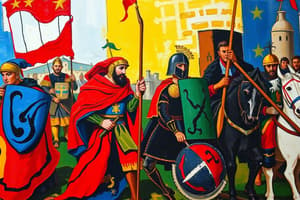Podcast
Questions and Answers
मध्यकालीन इतिहास का क्या क्षेत्रिय विस्तार था?
मध्यकालीन इतिहास का क्या क्षेत्रिय विस्तार था?
यूरोप, मेडिटेरेनियन, उत्तर अफ्रीका, और पश्चिमी एशिया
मध्यकालीन एवं मध्यकाल किस समय के बीच था?
मध्यकालीन एवं मध्यकाल किस समय के बीच था?
पांचवीं शताब्दी से 1500 ईसवी के आसपास
भारतीय उपमहाद्वीप किस क्षेत्र में आता था?
भारतीय उपमहाद्वीप किस क्षेत्र में आता था?
पश्चिमी ख्रिस्टेंडम
बाईजेंटाइम (पूर्वी रोमन साम्राज्य) किस क्षेत्र को शासित करता था?
बाईजेंटाइम (पूर्वी रोमन साम्राज्य) किस क्षेत्र को शासित करता था?
इस्लामी विश्व किस क्षेत्र को शासित करता था?
इस्लामी विश्व किस क्षेत्र को शासित करता था?
मध्यकाल का समयावधि किस वर्ग के बीच होता था?
मध्यकाल का समयावधि किस वर्ग के बीच होता था?
क्या था मध्यकालीन इतिहास का 'व्यापारी युग'?
क्या था मध्यकालीन इतिहास का 'व्यापारी युग'?
Flashcards are hidden until you start studying
Study Notes
Medieval History
Stepping into the captivating world of Medieval History is like delving through the pages of a sweeping epic saga, where chivalry, conflict, and cultural innovation intertwine against a backdrop stretching from the fall of Rome in the fifth century to the dawn of the Renaissance around the year 1500. This period encompasses the Middle Ages or Middle Ages (Middle Latin: medium aevum), which has shaped our current understanding of society, politics, economics, religion, and more.
Geographic Reach
The Middle Ages were dominated by several powerful civilizations centered across Europe, the Mediterranean, North Africa, and Western Asia. Key regions included:
- Western Christendom: Encompassing much of modern-day Italy, Switzerland, France, Spain, Portugal, Belgium, Luxembourg, Germany, Austria, Hungary, Slovakia, Czech Republic, western Poland, northern Serbia, Slovenia, Croatia, Bosnia & Herzegovina, Montenegro, and Albania.
- Byzantium (Eastern Roman Empire): Spanning present-day Greece, Turkey, Bulgaria, Romania, Ukraine, parts of Moldova, Georgia, Armenia, Serbia, Kosovo, Northern Cyprus, Lebanon, Syria, Jordan, Israel, Palestine, and western Iraq.
- Islamic World: Including North Africa, the Middle East, and Southwestern Asia, with centers such as Persian Iran, the Arabian Peninsula, Ottoman Anatolia, and Muslim Andalusia.
Major Events and Trends
Medieval history was punctuated by numerous events and trends that laid the foundations of our contemporary era. Some key moments include:
- Migration Period: From c. AD 400–600, barbarian tribes crossed over from Central Europe, bringing significant change to Western European societies as they established new kingdoms.
- Feudalism: In response to instability caused by invasions, fragmented territories took shape during this system characterized by hierarchical relationships between lords, vassals, and peasants based on land tenure.
- Crusades: Between the eleventh and thirteenth centuries, Christians embarked upon military campaigns known as Crusades aimed at recapturing the Holy Land from Muslims while also spurring trade and colonization throughout Eastern Europe and the Mediterranean.
- Hundred Years' War: Beginning in 1337, conflicts erupted between England and France, lasting nearly 118 years—a pivotal moment contributing to changes in feudal customs, warfare techniques, socioeconomic structures, and state formation.
- Rise of Nation States and Urban Centers: As populations shifted towards larger settlements, local identities became stronger, leading to the development of nationalist ideologies and urban governing bodies, setting the stage for modern nation states.
Everyday Life and Culture
Life in Medieval times did not solely revolve around political upheavals; it was filled with nuances embodying diverse social practices, religious beliefs, artistic expressions, and technological advancements. Some aspects of everyday life and culture during this time may seem unfamiliar yet nonetheless fascinating:
- Agricultural communities formed the bedrock of daily existence, cultivating crops and livestock in a subsistence economy.
- Religion played an indispensable role, with Christianity dominating Western civilization and Islam shaping the eastern half of the continent. Daily routines often involved church attendance, confession, and participation in pilgrimages.
- Chivalric codes emerged, emphasizing honor, bravery, courtesy, and love of God, fostering the growth of courtly literature and art.
- Artistic expression flourished, including architectural marvels such as cathedrals, frescoes, illuminated manuscripts, metalwork, and ivory carvings.
- Literacy rates remained low among laypeople, although monastic communities served as repositories of knowledge in scriptoria. Noteworthy works from this period include Geoffrey Chaucer's "Canterbury Tales," Dante Alighieri's "Divine Comedy," and "Le Morte d’Arthur” by Sir Thomas Malory.
- Technological advancements occurred, bolstered by the application of scientific principles developed by scholars of antiquity, resulting in inventions such as the astrolabe, windmill, waterwheel, spring clock, spectacles, playing cards, and even printmaking.
In summary, Medieval History invites us to explore the complex tapestry of human achievements and experiences spanning several centuries. Whether examining the rise and decline of kingdoms or celebrating the profound influence of chivalry upon today's chivalrous spirit, engaging with Medieval history provides unparalleled insight into the evolution of human civilization itself.
Studying That Suits You
Use AI to generate personalized quizzes and flashcards to suit your learning preferences.




